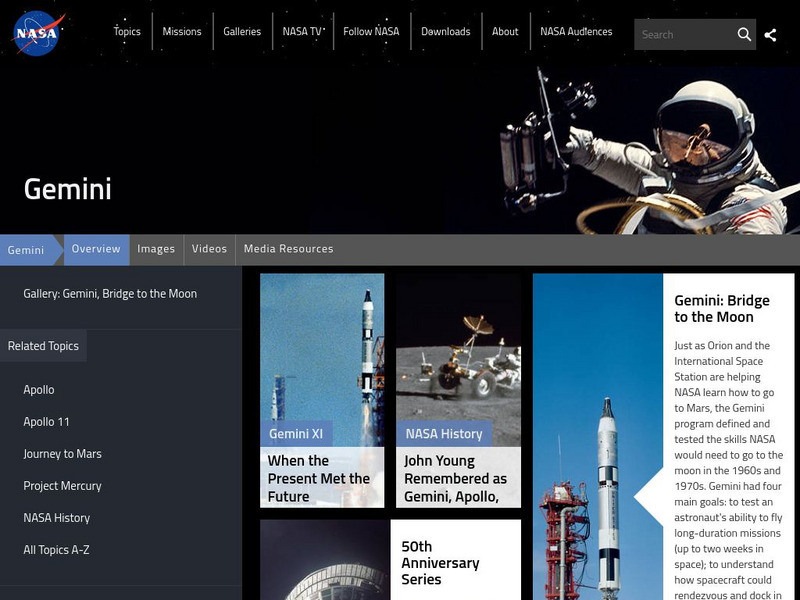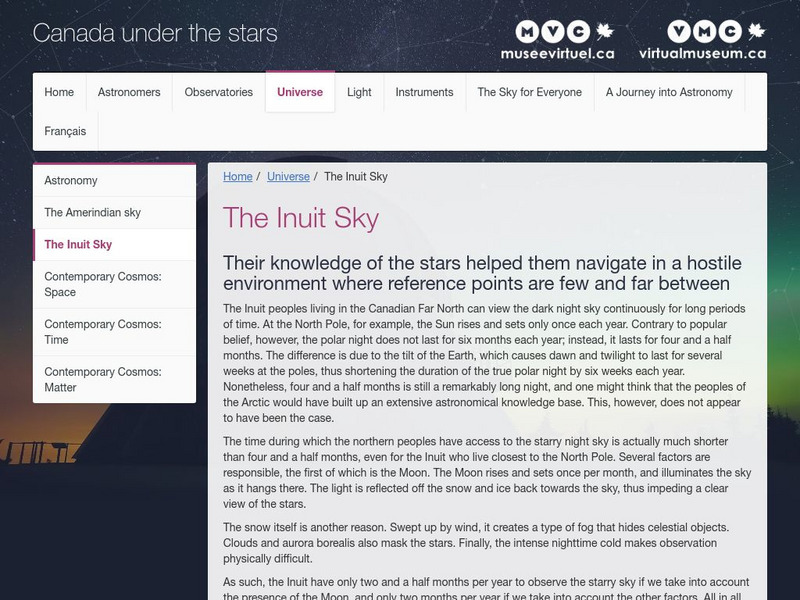A&E Television
History.com: How Many Times Has the u.s. Landed on the Moon?
Among seven Apollo moon landing missions, only one did not land men on the moon. Apollo 11 lunar module on July 20, 1969 to become the first human being to step foot on the moon. "That's one small step for man, one giant leap for...
Smithsonian Institution
National Air and Space Museum: Apollo to the Moon
This resource offers an in-depth exploration of the U.S. space program and the role President John F. Kennedy took in setting the agenda for manned space flight to the moon.
Other
The Ezra Jack Keats Foundation
Use this extensive Ezra-Jack Keats website. It gives a summary of the different books and looks at Keats as a person and author.
NASA
Nasa: Gemini: Stepping Stone to the Moon: 40 Years Later
On the 40th anniversary of the launch of Gemini XII, NASA offers a comprehensive overview of the manned space flight program that was the first to include two-man spacecraft and was designated Gemini in 1962.
White House Historical Association
White House Historical Association: John F. Kennedy and the Space Race
A look at John F. Kennedy's goal for the United States, which was to send the first man to the Moon and to bring him safely back to Earth. Informational text and lesson plan for students in grades 9-12.
Nobel Media AB
The Nobel Prize: The Nobel Prize in Literature 1936: Eugene O'neill
Read about the winner of the 1936 Nobel Prize in Literature, Eugene Gladstone O'Neill, who was honored "for the power, honesty and deep-felt emotions of his dramatic works, which embody an original concept of tragedy." This website is...
Scholastic
Scholastic Authors & Books: Paul Zindel's Biography
Scholastic's biography of Paul Zindel contains the author's memories of his early life, career choices, and reasons for writing: "I have to tell stories because that's the way the wiring went in."
British Library
British Library: 20th Century: Capturing and Creating the Modern
Discover the ways in which writers captured the fast-changing world around them during the 20th Century.
Khan Academy
Khan Academy: Codex Leicester: Fossils/mountains, Moon/tides
An excerpt from Leonardo da Vinci's Codex Leicester. Find out how this "Renaissance man" observed the Earth and learned more about tides, moons, and fossils in the mountains.
Other
Vmc: The Inuits the Sky of the First Inhabitants
The Inuit's knowledge of the stars helped them navigate in a hostile environment. In their legends, they did view the the Sun as being a woman, and the Moon as a man. Several stories are shared here.
British Library
British Library: 20th Century: Exploring Identity
Examine how writers have explored identity - through the prisms of ethnicity, class, gender, and sexuality - in the modern world.
Bibliomania
Bibliomania: Lewis Carroll Sylvie and Bruno Concluded
Here, read all 25 chapters of Lewish Carroll's "Sylvie and Bruno Concluded."
Other
Charlotte Zolotow: Paul Zindel Becomes an Author
Editor Charlotte Zolotow's large site offers this page about Paul Zindel, how they met, and how she influenced his creative life. Especially interesting is Zindel's description of all she brought to his life and craft as a writer.
Varsity Tutors
Varsity Tutors: Web English Teacher: Ray Bradbury
Explore the world of Ray Bradbury when you visit this educational resource. Each work is hyperlinked to study guide questions.
Wonderville Media
Wonderville: Neil Armstrong
Neil Armstrong was the first man to walk on the Moon. He was born on August 5, 1930, in Wapakoneta, Ohio. Learn more about Neil Armstrong in this well-constructed overview by Wonderville.







